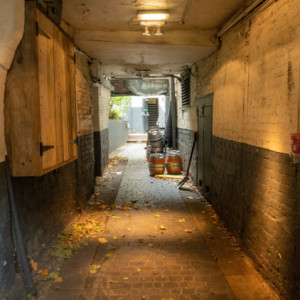The Swing Bridge over the Tyne
Following our fascinating guided walking tour a week past Tuesday, finishing with the climbing of Grey's Monument, I booked on another tour this afternoon by the same guide. This was a Quayside tour which should have culminated in a visit to the inner workings of the Swing Bridge. However the tour guide had to email those booked on the tour a few days ago to say that owing to unforeseen circumstances the Port of Tyne Authority (which is responsible for the bridge) was unfortunately unable to provide the necessary supervisor for us. We were given the opportunity to cancel (for a refund of our £6 charge) or just accept a Quayside-only tour. I reckoned he was such a knowledgeable, fascinating guide that I'd go anyway - and in fact there were only 3 of us who had not cancelled so it was a very select tour! I have however blipped the swing bridge - also note the big double-layer bridge behind it: the "High Level Bridge" (apparently the first double-layer bridge in the world - designed by Robert Stephenson and opened in 1849 - earlier than the Swing Bridge).
He really gave us our money's worth, with a tour lasting about an hour and three quarters, full of intriguing historical information - including that the river, up to a few hundred years ago, was about three times wider at Newcastle than it is now, the banks being built up with discarded ballast from trading ships (so the ground contains soil, rocks etc from several other countries!). This part of the tour included the alleyway shown in my extra which used to be an open alley but the buildings next to it eventually extended over it, producing this small tunnel.
The info about the Swing Bridge was really interesting. It was built in the 1870s on the site occupied by three previous bridges over the centuries. It was built by William Armstrong (the previous 1781 bridge was fixed and prevented larger ships reaching his engineering works further up the Tyne). At the time it was the largest swing bridge ever built and cost £240,000. Its busiest year was 1924 when it was opened 6,000 times; latterly it has been opened at least once a month to prevent the mechanism from seizing up. It was renovated in 2018 at a cost of £200,000 but its planned reopening was delayed until August 2021 by the Covid pandemic - when sadly the mechanism failed owing to deterioration of leather washers in the hydraulics. It is hoped that in time it can be repaired.
Our guide gave us an explanation of how it works (or should work!). It sounded a bit complicated but as I understand it, there is a "hydraulic accumulator" sunk 60 feet under the bridge into which water is pumped by an electric motor (originally a steam-driven motor). I gather that a very large weight is also slowly raised - ?by the same motor. Then when the bridge needs to open, the weight is dropped onto the water in the accumulator, forcing it under great pressure up through turbines which generate a large amount of electricity very quickly to power the motors which rotate the bridge structure.
Altogether a very interesting tour.


Comments
Sign in or get an account to comment.


